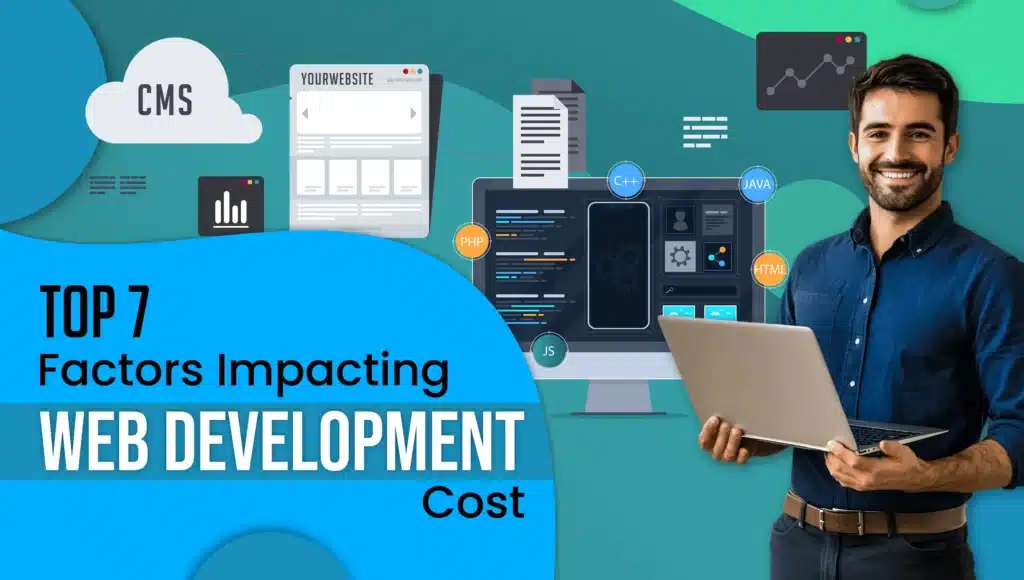Why Web Development Costs Can Skyrocket (Or Stay Lean)
Launching a website today isn’t optional—it’s the digital cornerstone of brand credibility. Yet, too many businesses underestimate the factors impacting web development cost and end up blindsided by scope creep, miscommunication, or poor planning.
According to GoodFirms, the average web development cost ranges from $2,000 to $75,000+, depending on complexity and features. That’s a wide range, and not understanding the key cost drivers is often the culprit.
This article breaks down the top 7 factors affecting web development cost, equipping you with data-driven insights to budget smartly and build right.
Current Trends in Web Development Cost (2025 Outlook)
Before diving into specifics, it’s essential to understand the market shifts shaping today’s pricing landscape:
- AI-Enhanced Development is reducing turnaround time but increasing initial tool investment.
- Global demand for UX/UI excellence is pushing up design costs.
- Cybersecurity compliance and GDPR-related architecture are becoming mandatory in most enterprise builds.
- International development teams make pricing more competitive but vary in output quality.
🔍 A Statista report projects that the global web development market will reach $89 billion by 2027, underscoring its critical role in business growth.
The 7 Key Factors Impacting Web Development Cost
1. Project Scope & Functionality
What drives cost:
More pages, more features, more integrations = more time and resources.
Examples of scope expansion:
- E-commerce functionalities (cart, payment, checkout, order tracking)
- Custom portals (dashboards, user logins, workflows)
- Multi-language support for international reach
Cost range impact:
$3,000–$50,000+ depending on features
Tip: Start with an MVP (Minimum Viable Product) if your budget is tight, then iterate post-launch.
2. Design Complexity and Customization
What drives cost:
Highly tailored UI/UX designs require strategy, wireframes, interactive mockups, and front-end polish.
Common design levels:
- Template-based: Budget-friendly but limited branding control
- Semi-custom: Some layout customization; moderate cost
- Fully custom: Designed from scratch; high cost
Cost range impact:
$2,000–$20,000+
Image Suggestion:
<img src=”custom-vs-template-design.png” alt=”Web development cost drivers – custom vs template design” />
3. Technology Stack Selection
What drives cost:
Tech choices directly influence development speed, scalability, and maintainability.
Examples:
- CMS (WordPress) vs. Headless CMS (Strapi, Sanity)
- Custom frameworks (React, Laravel, Next.js)
- Hosting environment (shared vs. cloud-based)
Cost range impact:
+15–40% based on tools and team proficiency
🧠 At Zellyo Digital, we match tech stacks to long-term growth strategies, not just the current phase.
4. Team Location and Expertise
What drives cost:
A developer in San Francisco costs significantly more than one in Dhaka or Warsaw—but experience matters more than geography.
Team Types:
- Freelancers: $25–$100/hr
- Offshore Agency: $30–$80/hr
- U.S./U.K. Agencies: $100–$250/hr
Pro Insight:
Hybrid models (e.g., offshore dev + Western PM) offer balanced quality and affordability.
5. Content Strategy & SEO Integration
What drives cost:
SEO-first builds require technical optimization, schema, page speed planning, and content integration from day one.
Inclusions:
- Keyword-driven content structure
- Metadata and on-page SEO
- Accessibility & performance audits
Cost range impact:
+10–30% on baseline dev cost
Related Post: How to Scale SEO with ChatGPT Tools
6. Timeline and Urgency
What drives cost:
Need a site launched in two weeks? Expect premium pricing.
Rush fees can add:
+20–50% to project cost, depending on complexity and resource availability
Recommendation:
Plan web development timelines 2–3 months in advance for best pricing and output quality.
7. Post-Launch Support & Maintenance
What drives cost:
Ongoing updates, backups, performance monitoring, plugin support, and bug fixes ensure long-term site health.
Models:
- One-time handoff
- Monthly retainer
- Dedicated support SLA
Cost range impact:
$50–$2,000/month depending on service level
🌐 Zellyo offers performance-driven Website Maintenance Plans that scale with your growth goals.
Actionable Framework: Cost Planning Checklist
Here’s a budget-aligned system you can apply today:
Discovery Phase:
- Define MVP features
- Identify must-have vs. nice-to-have
Budget Mapping:
- Cap maximum spend
- Add a 15% buffer for contingencies
Vendor Vetting:
- Request detailed proposals
- Check portfolio relevance
- Clarify deliverables vs. optional extras
Scope Control:
- Lock feature list in writing
- Use project management tools (e.g., ClickUp, Trello)
Review Points:
- Weekly check-ins
- Pre-launch QA across all devices/browsers
Real-World Application: Case Study Snapshot
Client: SaaS Startup (FinTech)
Scope:
Custom dashboard UI, subscription billing, and multilingual support
Initial Budget: $15,000
Final Cost: $22,000 (after adding CRM and analytics integrations)
Outcome:
- 43% increase in user retention
- 3x traffic in 90 days post-launch
- 0 bugs reported in the first 6 weeks
Takeaway: The Cost overrun was strategic. ROI justified every dollar.
FAQs: Factors Impacting Web Development Cost
How much does a basic website cost in 2025?
A basic business website starts at $3,000–$5,000, depending on design, platform, and developer experience.
What’s the biggest cost driver in web development?
Functionality and scope—custom features like dashboards, payments, or user systems dramatically increase development time and cost.
How do I avoid hidden development costs?
Ensure your proposal includes:
- Revisions
- Hosting
- Content population
- Post-launch support
Does using a template reduce cost significantly?
Yes. Templates can reduce UI design costs by 40–60%, but often come with tradeoffs in branding and UX.
Are international developers a good cost-saving option?
Yes, if properly vetted. Look for teams with proven processes, transparent communication, and international client experience.
How much should I budget for website maintenance?
Most businesses spend $100–$500/month for standard support. Enterprise sites may exceed $2,000 depending on SLA and tech stack.
Conclusion: Invest Smart, Build Right
Understanding the factors impacting web development cost isn’t just about saving money—it’s about investing wisely to drive digital performance.
From scope and design to tech stack and team expertise, each cost driver shapes not only the budget but also the ROI of your web presence.
If you’re serious about building a high-performance website that grows with your business, start with strategic clarity and expert execution.


